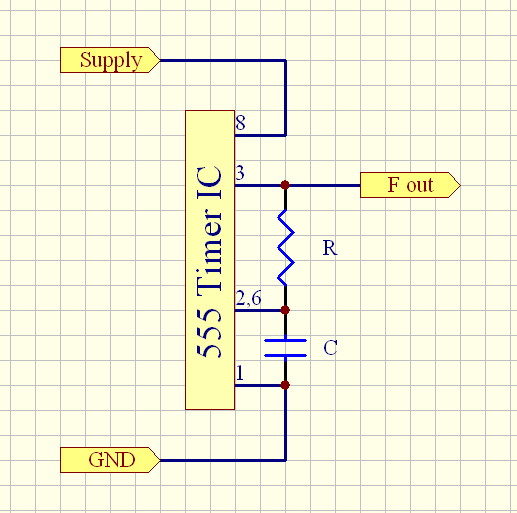Reduced component count 555 configuration ... anyone else used it like this?
 Beau Schwabe
Posts: 6,574
Beau Schwabe
Posts: 6,574
I was just curious if anyone else has used the 555 in this configuration? ... bonus if you could provide a formula, since supply voltage has an effect, as well as the flavor of the 555 you use. But if you just need a heartbeat, I prefer this configuration over the one that uses pins 4 and 7 with an additional resistor.
Anyway, just curious ... happy Friday!
Anyway, just curious ... happy Friday!



Comments
Somebody here will probably use some fancy computer circuit simulator to test it & see if it works, when building it on a breadboard would actually be much faster!
I've used that circuit with the TLC555. IIRC, the rail-to-rail CMOS output gives you a nice, symmetrical waveform. (Is this the new RC clock circuit for the Prop II?
-Phil
Actually that undoes one of my favorite things about the traditional 555 circuit, where its output frequency is not very voltage dependent.
For a standard astable circuit:
The charge time (output high) is given by - t1 = 0.693 (RA + RB) C.
The discharge time (output low) by - t2 = 0.693 (RB) C.
The total period is - T = t1 + t2 = 0.693 (RA +2RB) C.
For your astable circuit:
The charge time (output high) is given by - t1 = 0.693 R C.
The discharge time (output low) by - t2 = 0.693 R C.
The total period is - T = t1 + t2 = 0.693 2R C.
The only difference I can see is that the charging voltage will be lower due to having a transistor between R and the supply voltage. That voltage drop is fairly significant at lower supply voltages. That affects the charge/discharge constant (0.0693) since the internal comparators are referenced to the supply and the capacitor is charged by the supply – (transistor voltage drop).
-Phil
"Actually that undoes one of my favorite things about the traditional 555 circuit, where its output frequency is not very voltage dependent." - It's not a huge amount... I needed this circuit for a heartbeat in a solar application ... about 5kHz ... with a voltage range fro 5V to 15V the frequency was within 1kHz
Fosc = 1 / (1.4 * R * C).
It is 50% of course because of the symmetry of the CMOS output. It is possible to do something like that with a standard bipolar 555, but that requires a pullup R at the output, and is nowhere as neat as the CMOS version. My favorite by far is the National LMC555. Even in 1988, it could operate with symmetrical output down to 1.5V. The circuit is found in compilations too, like the IC Timer Cookbook.
The circuit is part of the conductivity measurement chapter in "Applied Sensors", where it applies the symmetrical AC waveform through isolating capacitors to the sensor probes. The probes are part of the frequency-determining network.
"Old as the hills, Beau." - Absolutely right, I know, so why does it get swamped with the 'more component/ more pins' version when you search for a circuit? ... Shouldn't that be the other way around? I mean use the simple circuit, but if you want more precision/control, here is what you can do... It just seems backwards to me. A lot of things in this world are like this and our vision is often blurred with unnecessary complexities.
My Freq & Duty need to be fairly constant, but I'll give this a shot anyways
Thank you for posting.
'
You don't really need to tie-up a Micro for such a simple task.
'
Unless the frequency needs to be very very precise.
'
Yet another Pitfall.
'
Micros aren't designed to be precise oscillators, But to run code with a descent timing value.
Beau wrote, " so why does it get swamped with the 'more component/ more pins' version when you search for a circuit? ... Shouldn't that be the other way around?" Indeed! that could be said of much popular technology.
Ak! using a 555 in a solar application? Those things are thirsty little buggers. They have quiescent currents of a couple of mA at least. Building a hysteresis oscillator out of a 74C14 or 4000B inverter would get consumption down to the 100uA ballpark. If you really want low power, I'd suggest using a comparator. The MCP6542 gets into the 1uA ballpark, but would pop at 15V. The TLC3702 would let the circuit run at ~18uA + whatever the feedback network needed.
Lawson
The input capacitance of a 30A mosfet will approach 1000pf. The average current to charge and discharge that at 20V will approach 10 mA and it will really need those high current surges for the edges.
On PhiPi's recommendation, I got ahold some of the Micrel mosfet drivers, MIC4223 series, very nice, which can provide 4A pulse of current at the output on a power supply of up to 18V. It occurs to me that you might take one of the inverting outputs and couple it around to the input thru an RC, and turn it into an oscillator.
@Tracy: Unless that Micrel part has Schmidt triggered inputs it'll need to provide a buffered and inverted version of the inputs to function as an oscillator. (buffered would drive the timing cap, while inverted would get the timing resistor)
Lawson
-Phil